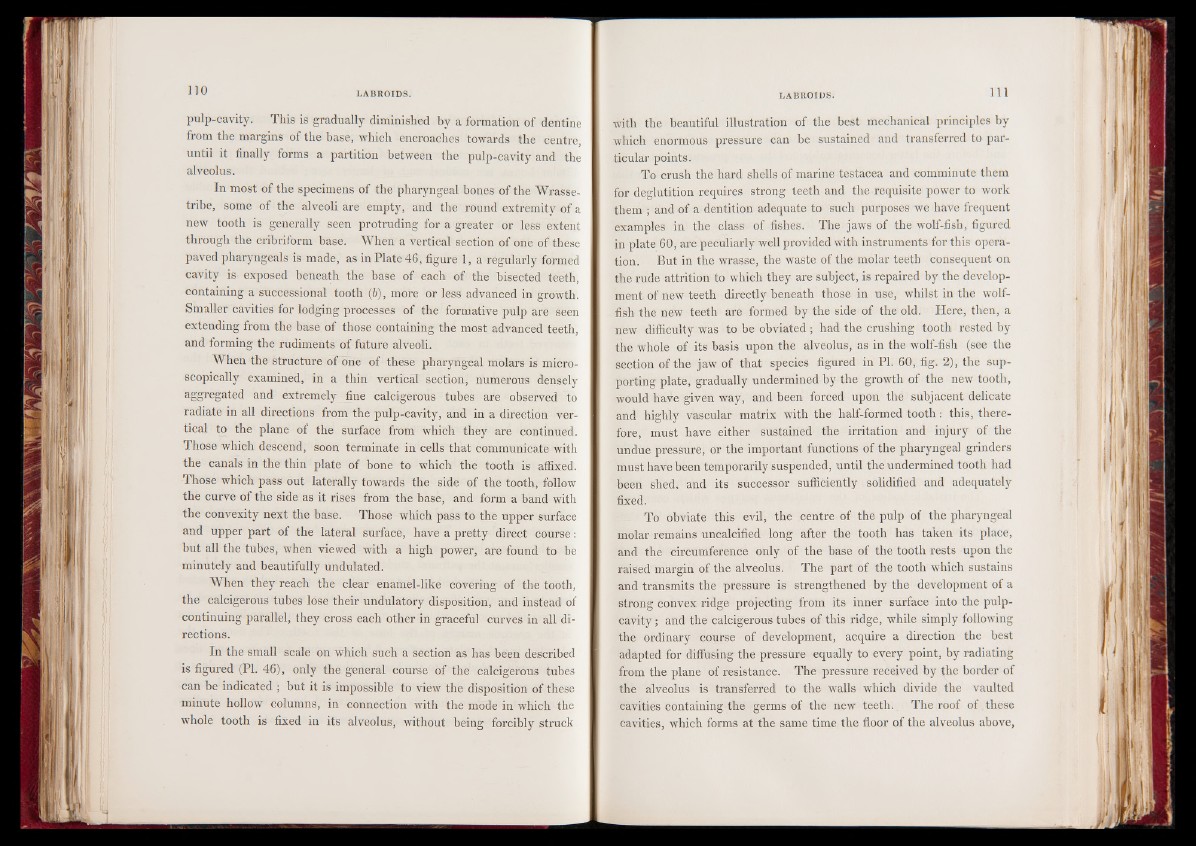
pulp-cavity. This is gradually diminished by a formation of dentine
from the margins of the base, which encroaches towards the centre,
until it finally forms a partition between the pulp-cavity and the
alveolus.
In most of the specimens of the pharyngeal bones of the Wrasse-
tribe, some of the alveoli are empty, and the round extremity of a
new tooth is generally seen protruding for a greater or less extent
through the cribriform base. When a vertical section of one of these
paved pharyngeals is made, as in Plate 46, figure 1, a regularly formed
cavity is exposed beneath the base of each of the bisected teeth,
containing a successional tooth (&), more or less advanced in growth.
Smaller cavities for lodging processes of the formative pulp are seen
extending from the base, of those containing the most advanced teeth,
and forming the rudiments of future alveoli.
When the structure of one of these pharyngeal molars is microscopically
examined, in a thin vertical section, numerous densely
aggregated and extremely fine calcigerous tubes are observed to
radiate in all directions from the pulp-cavity, and in a direction vertical
to the plane of the surface from which they are continued.
Those which descend, soon terminate in cells that communicate with
the canals in the thin plate of bone to which the tooth is affixed.
Those which pass out laterally towards the side of the tooth, follow
the curve of the side as it rises from the base, and form a band with
the convexity next the base. Those which pass to the upper surface
and upper part of the lateral surface, have a pretty direct course :
but all the tubes, when viewed with a high power, are found to he
minutely and beautifully undulated.
When they reach the clear enamel-like covering of the tooth,
the calcigerous tubes lose their undulatory disposition, and instead of
continuing parallel, they cross each other in graceful curves in all directions.
In the small scale on which such a section as has been described
is figured (PL 46), only the general course of the calcigerous tubes
can be indicated ; but it is impossible to view the disposition of these
minute hollow columns, in connection with the mode in which the
whole tooth is fixed in its alveolus, without being forcibly struck
with the beautiful illustration of the best mechanical principles by
which enormous pressure can be sustained and transferred to particular
points.
To crush the hard shells of marine testacea and comminute them
for deglutition requires strong teeth and the requisite power to work
them ; and of a dentition adequate to such purposes we have frequent
examples in the class of fishes. The jaws of the wolf-fish, figured
in plate 60, are peculiarly well provided with instruments for this operation.
But in the wrasse, the waste of the molar teeth consequent on
the rude attrition to which they are subject, is repaired by the development
of new teeth directly beneath those in use, whilst in the wolffish
the new teeth are formed by the side of the old. Here, then, a
new difficulty was to be obviated ; had the crushing tooth rested by
the whole of its basis upon the alveolus, as in the wolf-fish (see the
section of the jaw of that species figured in PL 60, fig. 2), the supporting
plate, gradually undermined by the growth of the new tooth,
would have given way, and been forced upon thé subjacent delicate
and highly vascular matrix with the half-formed tooth: this, therefore,
must have either sustained the irritation and injury of the
undue pressure, or the important functions of the pharyngeal grinders
must have been temporarily suspended, until the undermined tooth had
been shed, and its successor sufficiently solidified and adequately
fixed.
To obviate this evil, the centre of the pulp of the pharyngeal
molar remains uncalcified long after the tooth has taken its place,
and the circumference only of the base of the tooth rests upon the
raised margin of the alveolus. The part of the tooth which sustains
and transmits the pressure is strengthened by the development of a
strong convex ridge projecting from its inner surface into the pulp-
cavity ; and the calcigerous tubes of this ridge, while simply following
the ordinary course of development, acquire a direction the best
adapted for diffusing the pressure equally to every point, by radiating
from the plane of resistance. The pressure received by the border of
the alveolus is transferred to the walls which divide the vaulted
cavities containing the germs of the new teeth. The roof of these
cavities, which forms at the same time the floor of the alveolus above,